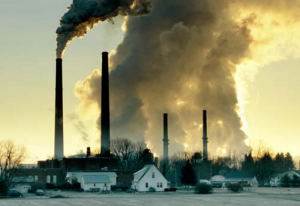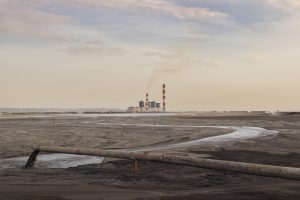Coal has an enormous environmental footprint.
Over 200 coal-fired power plants across the U.S. account for around a fifth of the nation’s carbon dioxide emissions from fossil fuels, as well as releases into the air of soot-like particles, mercury, sulfur dioxide, and nitrogen oxides that cause heart and asthma attacks, pollute waterways, and contaminate fish.
These same coal-fired power plants also pipe millions of pounds of arsenic, lead, mercury, and other toxins directly into our rivers and streams. In fact, EPA has determined that coal-fired generators are the largest industrial source of toxic water discharges in the U.S. today.
The enforcement of the Clean Water Act and Clean Air Act has helped to decrease some pollution. But some plants still release thousands of tons of pollutants that contribute to lung and cardiac disease and premature death. Power plants also generate over 100 million tons of coal ash and waste sludge every year, enough to fill a line of boxcars from the U.S. to Australia. Much of that waste is dumped, untreated, into unlined pits and ponds that can leak chemicals into groundwater. Several big ash ponds, have collapsed in recent years spilling millions of gallons of sludge into public waterways.
Since our founding in 2002, the Environmental Integrity Project has been highly effective in combating this air and water pollution by pushing EPA for stronger regulations and by taking legal actions against the agency when its actions do not comply with the law and against utilities that jeopardize public health by not following the rules.
Climate Change and Toxic Air Pollution
 Too many coal-fired power plants still do not meet clean air or water standards that have been on the books since the 1980s. Enforcing these laws can encourage retirement and replacement of the dirtiest units with the cleaner alternatives we need to fight climate change. Energy conservation and the rapid growth of wind and solar power also play huge roles in our transition away from coal.
Too many coal-fired power plants still do not meet clean air or water standards that have been on the books since the 1980s. Enforcing these laws can encourage retirement and replacement of the dirtiest units with the cleaner alternatives we need to fight climate change. Energy conservation and the rapid growth of wind and solar power also play huge roles in our transition away from coal.
Some coal plants emit hundreds of tons of air pollutants every year because their outdated equipment does not control emissions when boilers start up and shut down. Many states have been revising their rules governing plant startup and shutdown in response to an EPA requirement to do so, and we have been working to ensure that those state rules contain meaningful and enforceable provisions. In addition, we have filed lawsuits to force EPA to eliminate loopholes that allow power plants to avoid compliance with toxic emission limits during startup and shutdown. Because emission limits are meaningless without accurate monitoring, we also challenge rules and permits that make it too easy for power plants to hide their pollution.
We team up with community organizations and other environmental groups to advocate for long-delayed rules and regulations that limit toxic air and water pollution from coal plants. Proposals to build high-polluting power plants in Bay City and Corpus Christi (South Texas) were withdrawn after we successfully challenged their failure to comply with the Clean Air Act. Utilities also retired coal plants in Maryland and Tennessee following our long-term efforts to enforce permit limits to reduce air and water pollution.
Coal Ash: Polluting our Groundwater and Streams
Coal ash, a byproduct from the combustion of coal, is one of the largest industrial waste streams in the U.S. and contains toxic metals like arsenic, lead, and mercury. Most of this ash is dumped, untreated, into unlined landfills and ponds, and can often leak toxins into the groundwater and streams. EPA has determined that over 150 of these coal ash sites have or may have polluted groundwater or surface waters at levels threatening human health and the environment.
 After a billion-gallon spill from a Tennessee power plant in 2008, we teamed with Earthjustice and other groups to press for federal coal ash disposal rules to protect public health. As a result, in December 2014, EPA issued the nation’s first federal rules for ash landfills and waste ponds. We also negotiated a settlement that requires EPA to set national limits on toxic wastewater discharges into rivers, streams, and lakes in September 2015.
After a billion-gallon spill from a Tennessee power plant in 2008, we teamed with Earthjustice and other groups to press for federal coal ash disposal rules to protect public health. As a result, in December 2014, EPA issued the nation’s first federal rules for ash landfills and waste ponds. We also negotiated a settlement that requires EPA to set national limits on toxic wastewater discharges into rivers, streams, and lakes in September 2015.
Setting deadlines for pollution control rules is one step. We also develop the technical and legal arguments to justify tougher standards. Meanwhile, our enforcement actions have helped secure closure and a $169 million cleanup of First Energy’s 1,300-acre ash pond in Pennsylvania, requirements for partial cleanup and reforms at a coal-ash dump in LaBelle, Pennsylvania, and the cleanup of three leaking landfills in Maryland.
For more information about coal ash, visit our Ashtracker page, which makes it easier for the public to review groundwater contamination data from specific disposal sites.
Wastewater
 Coal-fired power plants are responsible for almost a third of the industrial toxic pollution discharged to our rivers and streams. Coal ash that builds up in boilers and pollution control equipment is flushed out with water and directed into settling ponds, which are regularly discharged into rivers and streams. This wastewater contains toxins like arsenic, mercury, and selenium, which are harmful to humans, wildlife, and the environment.
Coal-fired power plants are responsible for almost a third of the industrial toxic pollution discharged to our rivers and streams. Coal ash that builds up in boilers and pollution control equipment is flushed out with water and directed into settling ponds, which are regularly discharged into rivers and streams. This wastewater contains toxins like arsenic, mercury, and selenium, which are harmful to humans, wildlife, and the environment.
In part because of the legal efforts of the Environmental Integrity Project and allies, EPA in 2015 published long overdue regulations that require the use of more modern technologies to treat wastewater. The rules are expected to eliminate over 90 percent of the toxic pollution discharged into the environment. However, an EIP report “Toxic Wastewater from Coal Plants,” released in August 2016, revealed that these expected environmental improvements could be delayed or derailed by a backlog of expired state permits for power plants and poor monitoring.


